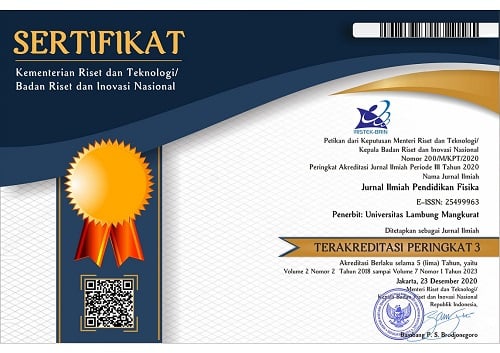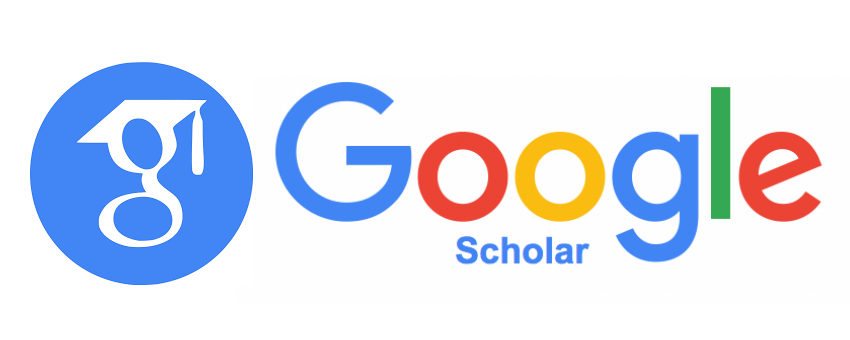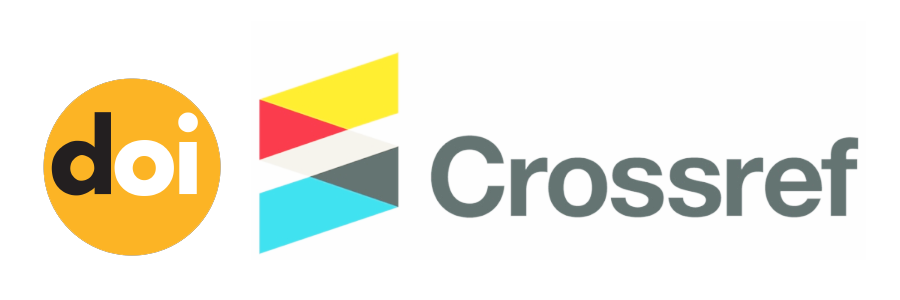Penerapan Virtual Laboratory untuk Mereduksi Jumlah Mahasiswa Calon Guru Fisika yang Mengalami Miskonsepsi Tentang Efek Foto Listrik
Abstract
Penelitian ini menggunakan virtual laboratory untuk mereduksi jumlah mahasiswa calon guru fisika yang mengalami miskonsepsi tentang efek foto listrik. One group pretest-posttest design digunakan sebagai rancangan penelitian. Ada 45 mahasiswa yang terlibat dalam menjawab 12 soal tes diagnostik berbentuk pilihan dengan alasan terbuka yang digunakan sebagai alat pengumpul data. Hasil penelitian menunjukkan terjadi perubahan konseptual mahasiswa tentang efek foto listrik yang signifikan setelah pembelajaran menggunakan virtual laboratory diterapkan yang ditandai dengan rata-rata 15x2"> hitung (10,51) > 15x2"> tabel(3,84) pada semua indikator; rata-rata persentase reduksi jumlah mahasiswa yang miskonsepsi setelah penerapan virtual laboratory sebesar 21,35%. Virtual laboratory diharapkan dapat dijadikan sebagai solusi untuk mereduksi jumlah mahasiswa yang mengalami miskonsepsi pada materi yang lain terlebih di masa pandemi dimana eksperimen secara langsung sulit dilakukan.
This research uses a virtual lab to reduce the number of pre-service physics teacher misconceptions about the photoelectric effect. One group pretest-posttest design was used as the research design. There were 45 students involved in answering 12 selected diagnostic test questions for open reasons, which were used as a data collection. The results showed a significant students' conceptual change in photoelectric effect after learning using the virtual lab, marked with 15x2"> count > 15x2"> table on all indicators; the average percentage reduction in the number of students with misconceptions after the virtual lab was applied was 21.35%. Virtual labs are expected to be used to reduce the number of misconceptions students have on other subject matter, especially during a pandemic where real experiments are difficult to do.
Keywords
Full Text:
PDFReferences
Admoko, S., Yantidewi, M., & Oktafia, R. (2019). The implementation of guided discovery learning using virtual lab simulation to reduce students’ misconception on mechanical wave. Journal of Physics: Conference Series, 1417. https://doi.org/10.1088/1742-6596/1417/1/012089
Diani, R., Latifah, S., Anggaraeni, Y. M., & Fujiani, D. (2018). Physics learning based on virtual laboratory to remediate misconception in fluid material. Tadris: Jurnal Keguruan Dan Ilmu Tarbiyah, 3(2), 167–181.
Ghadiri, Z., Norouzi, D., & Fardanesh, H. (2016). Investigation of the effect of computer simulation-based learning based on constructivism in removing physics misconceptions. Interdisciplinary Journal of Virtual Learning In Medical Sciences, 6(4), 30–41.
Halim. (2021). The impact of PhET virtual lab worksheets on student learning outcomes on sound wave materials. Journal of Physics: Conference Series, 1806. https://doi.org/10.1088/17426596/1806/1/012033
Hamdani, H. (2015). Penerapan virtual laboratorium untuk mereduksi miskonsepsi mahasiswa tentang fluida. Jurnal Visi Ilmu Pendidikan, 7(3), 1781–1788.
Hamdani, H. (2020). Miskonsepsi mahasiswa tentang efek foto listrik. Jurnal Visi Ilmu Pendidikan, 12(2), 108–113.
Hasanah, D. I., & Wasis, W. (2021). Cognitive cognitive conflict strategy assisted by PhET simulation to remediate student misconceptions on wave material. Asatiza: Jurnal Pendidikan, 2(1), 19–32. https://doi.org/https://doi.org/10.46963/asatiza.v2i1.247.
Namgyel, T., & Buaraphan, K. (2017). The development of simulation and game in 5e learning cycle to teach photoelectric effect for grade 12 students. Asia-Pasific Forum on Science Learning and Teaching, 18(2).
Posner, G. J. (1982). Accomodation of a scientific conception: toward a theory of conceptual change. Science Education, 66(2), 211–227.
Prastiwi, A. C., Kholiq, A., & Setyarsih, W. (2018). Implementation of ECIRR model based on virtual simulation media to reduce students’ misconception on kinetic theory of gases. Journal of Physics: Conference Series, 997. https://doi.org/10.1088/1742-6596/997/1/012034
Siswoyo. (2015). Pemahaman mahasiswa tentang efek foto listrik. Jurnal Penelitian Dan Pengembangan Pendidikan Fisika, 1(1).
Sugiyono. (2012). Statistika Untuk Penelitian. Alfabeta.
Taslidere, E. (2016). Development and use of a three-tier diagnostic test to assess high school students’ misconceptions about the photoelectric effect. Journal Research in Science & Technological Education, 34(2), 1–23.
Upayogi, I. N. T., & Juliawa, I. W. (2019). Reduksi miskonsepsi melalui pembelajaran berbasis virtual lab. Journal of Teaching and Learning Physics, 4(2), 45–43.
Widyawati, E., Jatmiko, B., & Widodo, W. (2019). Learning development of cooperative model based phet media to reduce potential misconceptions in dynamic electric matter for tenth grade in state senior high school. International Journal of Innovative Science and Research Technology, 4
DOI: https://doi.org/10.20527/jipf.v6i2.4810
Refbacks
- There are currently no refbacks.
Indexed by: Jurnal Ilmiah Pendidikan Fisika is licensed under a creative commons attribution-share alike 4.0 international license
Statistics Counter |
















